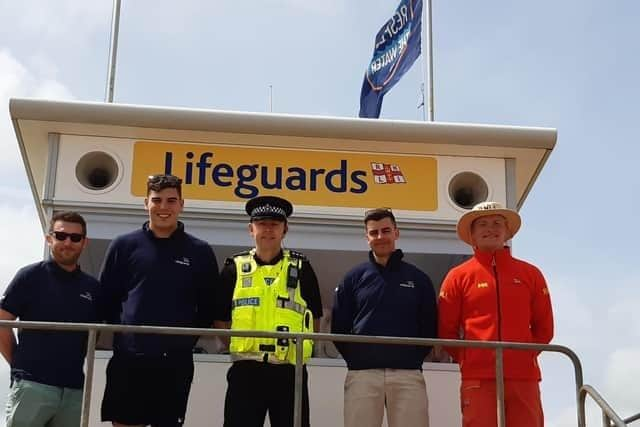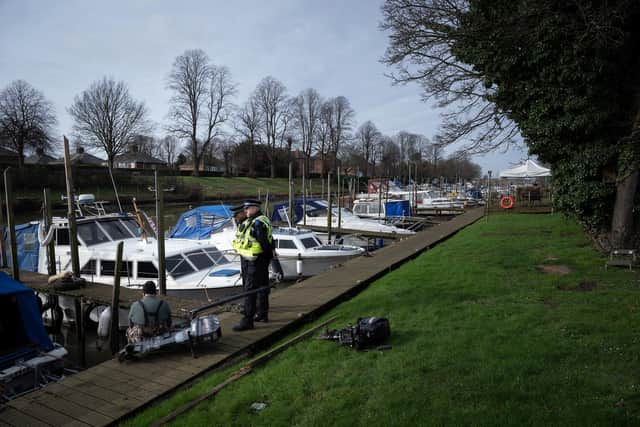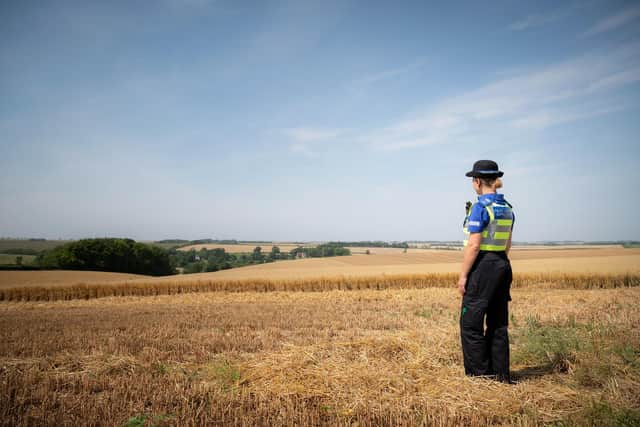New neighbourhood policing plans driving down crime with a little help from 'friends'


Many of our communities had already expressed concern about what they felt was a lack of police presence on the streets, with the sight of regular bobbies on the beat becoming a distant memory.
One by one we have said farewell to popular faces that were always at local events or fronting crime-busting campaigns.
Advertisement
Hide AdAdvertisement
Hide AdHowever amidst the concerns, on the coast a cunning plan was being hatched by a senior police officer to beat the challenges brought about by cuts in resources with a little help from his ‘friends’.


A variety of partners – such as HM Coastguard, the Environment Agency, Just Lincolnshire, NHS Lincolnshire, St John Ambulance, Pub and Shop Watch, Safer Together, District Councils, Lincolnshire Road Safety Partnership and Lincs Fire and Rescue – were brought in so they could assist each other in keeping the county safe.
Superintendent Lee St Quinton, who led on last year’s successful Summertime Policing Plan on the East Coast and earlier this year earned a promotion to a county role, is now rolling the campaign out to the rest of the county, with one big difference – the new Neighbourhood Plans are not just for summer but for the whole year.
“This is our promise to the people who live, work and visit each of our neighbourhood areas,” said Superintendent Lee St Quinton.
Advertisement
Hide AdAdvertisement
Hide Ad“Each local inspector or chief inspector has outlined what they are committing to in terms of their teams’ particular responsibilities: it could be a focus on speeding, tackling child sexual exploitation, or drugs in the nighttime economy.


“The feedback we received from the summertime plan was that people liked the discussion of local priorities and targeted action – what we do on the ground, so to speak - so that’s what we’ve reflected with these bespoke plans.
“Our teams engage with people throughout the year, with priority setting taking place every three months. At those meetings we might take a look at our commitment to tackle speeding, for instance, and then outline the specific areas that we’ll target.
“And that’s what the neighbourhood teams will work on – resolving issues that affect you.”
Advertisement
Hide AdAdvertisement
Hide AdLincolnshire Police first outlined their community priorities in a new Neighbourhood Policing model following the reduction in PCSO numbers in January this year.


The new model ensures that they have maintained Community Beat Managers (CBMs), sergeants and inspectors dedicated to every area. The numbers of police officers in neighbourhood policing have also been bolstered in the past 18 months with the recruitment of a further 13 CBMs.
Countywide statistics on work already put in place speak for themselves. In December last year compared to the same month in 2022 statistics show falls in recorded crimes for robbery against the person (-13%); residential burglary (-26.9%); vehicle crime (-13.7%); theft from the person (-14.2%); arson and criminal damage (-9.5%) and public order offences (-14.9%).
Shoplifting showed a rise of 24.3% - from 358 offences to 445 offences – which showed that there remains work to do. But this is where the new Neighbourhood Policing model will target the areas most in need and the crime types which cause the highest levels of harm in communities.
Advertisement
Hide AdAdvertisement
Hide AdAll areas will also be covered by an individual Neighbourhood Plan which includes crime and anti-social behaviour data, in addition to other information, to set Community Priorities.
Neighbourhood policing teams (NPTs) have set out in eight new accessible plans how they will keep communities safe.
Each NPT area features its own unique characteristics and challenges and teams have listened throughout the year to those who live and work there to understand their concerns.
In the past year, for instance, police have reduced the number of caravan burglaries on the east coast, and made a real impact on drugs supply in West Lindsey.
Advertisement
Hide AdAdvertisement
Hide AdEast Coast Insp Jacqueline Evans said her area faced the challenges of a tenfold rise in population in the summer due to tourism. She said: “Skegness alone sees 2.3 million visitors a year.
"The town sees its population rise from approximately 20,000 to 250,000 in the height of the summer.
"With 36,000 caravans across 262 sites, it is easy to see the challenges we face with the influx of visitors.
“Last year saw the launch of the Summertime Policing Plan which is a structured approach.
Advertisement
Hide AdAdvertisement
Hide Ad"This year’s plan will look to take on the successes of last year and improve and build on those.”
West Lindsey’s Insp Michael Head is also taking a proactive approach. He said: “In the last 14 months the teams in West Lindsey have conducted more than 30 warrants taking dangerous weapons and drugs off the street.
"We have also increased the amount of Criminal Behaviour Orders (CBO) for the district by 33%.”
With a population of around 46,000 people, Boston is the second largest conurbation in the Lincolnshire policing area.
Advertisement
Hide AdAdvertisement
Hide AdNPTs in Boston have been undertaking crime hotspot patrols and have reduced ASB linked to street drinking by 50% in 2023 compared to previous years.
"The team will continue to focus on this as an area of need and are aiming to reduce incidents of this nature even further,” said T/Insp Ian Cotton.
South Holland with its wealth of diverse communities has seen a rise in tourism interest more recently with the return of the Spalding Flower Parade.
The A16, A17 and A52 run through South Holland resulting in significant vehicle traffic and roads policing issues.
Advertisement
Hide AdAdvertisement
Hide Ad“Our officers and partners work hard to police South Holland and I see every day how they leave a positive impact on the communities
they operate within,” said Inspector Matt Dickinson. “This plan will allow us to continue to build on this good work.”
North Kesteven including Sleaford boasts one of the safest places to live in terms of lowest recorded crimes per head of population. However, according to the Plan, NPTs recognise ongoing issues and will work with investigators responsible for volume crime, serious crime and crimes against children and vulnerable people as well as dedicated intelligence officers to keep communities safe.
Insp Rachel Blackwell said: “We work daily with these partners to deal effectively with crime and disorder issues.”
Advertisement
Hide AdAdvertisement
Hide AdThe Wolds area is spread over almost 220 square miles and forms part of East Lindsey District which is amongst the largest districts in the country.
A popular area for tourism with more than half a million visitors during key months, the roads carry all of the traffic to the coast.
The geography and distances involved present challenges to policing.
However, Wolds Insp Matt Bennison said: “Over the coming year I will be working closely with other departments within the police service along with our external partners to ensure that the Wolds remains for policing with sporadic issues in our a safe place to live, work and visit.”
Advertisement
Hide AdAdvertisement
Hide AdSince launching on April 1, the Plans were being well-received in the county’s individual Neighbourhoods, said Supt St Quinton.
"We believe we are stronger together and with the launch of the Plans communities will understand what is happening when they see us out with partner agencies,” he added. “We hope communities will feel they can engage with us and become part of it.”
You can download the Neighbourhood Policing Plan for your area by visiting the Lincolnshire Police website at lincs.police.uk/news